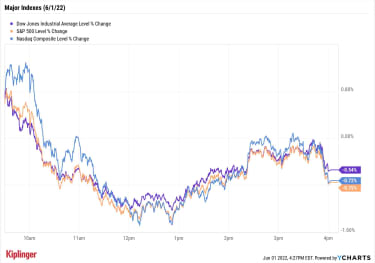Stock Market Today
June kicked off with another up-and-down day as Wall Street digested signs of economic slowing and a more hawkish Fed.More pockmarks on the prospects for the U.S. economy sent America’s major stock indexes into a near-360 during June’s first trading session.
JPMorgan Chase (JPM, -1.8%) CEO Jamie Dimon unnerved some on Wall Street after telling a financial conference that he’s preparing his own bank for more turbulent times to come. “You know, I said there’s storm clouds, but I’m going to change it … it’s a hurricane,” he said, adding that investors should “brace yourself.”
Economic data didn’t help much to quell those fears. The Labor Department’s Job Openings and Labor Turnover Survey (JOLTS) showed that job openings declined by 455,000 in April to 11.4 million, from 11.9 million in March. That sets up a possible cooling in the May jobs report due out Friday morning.
“We’ve enjoyed 12 consecutive months of payroll growth north of 400,000, but that streak is close to an end,” says Greg McBride, chief financial analyst at Bankrate. “Job growth will continue, but at a more modest pace in the months ahead as the Federal Reserve works to slow the economy and corral inflation.”
However, also Wednesday, the Institute for Supply Management’s May manufacturing report showed that manufacturing activity remained robust, delivering a reading of 56.1 last month vs. 55.4 in April and 54.5 expected. (Anything over 50 implies expansion.)
Following on remarks from Federal Reserve Governor Christopher Waller suggesting the central bank might need to continue tightening monetary policy, James Bullard, president of the Federal Reserve Bank of St. Louis, told the Economic Club of Memphis that “I think we’re on the precipice of losing control of inflation expectations.”
Sign up for Kiplinger’s FREE Investing Weekly e-letter for stock, ETF and mutual fund recommendations, and other investing advice.
And San Francisco Fed President Mary Daly said the central bank should be aggressive with rate hikes until inflation is tamed. “We need to do that expeditiously, and I see a couple of 50-basis-point hikes immediately in the next couple of meetings to get there,” she said.
That sent traders’ views on the likelihood for another 50-basis-point hike in September to 60%, from 55% yesterday, according to the CME FedWatch Tool. Bonds sold off again as a result, sending the 10-year Treasury yield to as high as 2.95%.
Energy (+1.6%) was the only sector showing any real strength; U.S. crude oil futures improved by 0.5% to $115.26 per barrel as Shanghai began ending its two-month COVID-related lockdown.
The major indexes, meanwhile, started in the green, plunged deep into the red by noon, then spent the rest of the afternoon clawing away at most (but not all) of those losses. The Dow Jones Industrial Average declined 0.5% to 32,813, the S&P 500 was down 0.8% to 4,101, and the Nasdaq Composite shed 0.7% to 11,994.
YCharts
Other news in the stock market today:
The small-cap Russell 2000 declined 0.5% to 1,854.Gold futures improved by 0.3% to $1,843.30 per ounce. Bitcoin declined 4.9% to $30,104.76. (Bitcoin trades 24 hours a day; prices reported here are as of 4 p.m.) Salesforce.com (CRM) shares rocketed ahead by 9.9% after the company topped first-quarter estimates and raised its full-year outlook. Profits of 98 cents per share and revenues of $7.41 billion topped views for 94 cents and $7.38 billion, respectively. Meanwhile, CRM now expects $4.74 to $4.76 per share in full-year adjusted earnings, versus $4.62 to $4.64 per share previously. “Last night Salesforce delivered a much better than feared April quarter and guidance which will be a major relief for tech investors showing that core enterprise demand is holding up well despite the macro and geopolitical swirls,” says Wedbush’s Daniel Ives, who rates the stock at Outperform.Take a Shot on Chinese Stocks?If it’s any consolation (probably not), the U.S. isn’t the only place in the world experiencing deep year-to-date losses and nauseating volatility.
Take China, for instance. This country has long been considered one of the greatest growth plays in emerging markets. However, hyper-strict governmental regulatory crackdowns in the technology space, as well as a resurgent wave of COVID that sparked shutdowns in several large population centers, have cut the Morningstar China Index’s value by roughly a third in 2022.
Yes, Chinese equities have enjoyed a small bump of late as governmental figures have given a token nod to the country’s enormous technology sector. But strategists are skeptical that this will translate into any substantial changes in the country’s stance long-term. Other hurdles remain, too.
“Domestic consumption remains weak, the housing market is sluggish, the online retail sector is saturated and Chinese stocks continue to face the risk of being delisted from foreign exchanges,” says BCA Research.
And yet, equity researchers remain extremely bullish on a number of Chinese stocks. Much of that has to do with valuation – excessive stock losses have made many of these companies attractive, even in a perilous macro environment. Beware that some of it merely reflects the potential for a near-term rebound, not necessarily confidence in a favorable long-term setup. Still, nimble investors looking to generate excess returns in a tumultuous 2022 might find a few candidates among these five Chinese picks.
